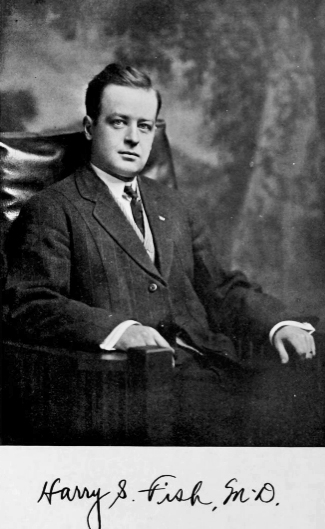Summer Quarterly features article on "community aristocrat"

SAYRE - A Sayre surgeon who helped found the People's Hospital, guided the formation of the World War I Canteen and achieved fame nation-wide as a public speaker is the featured story in the Sayre Historical Society's Quarterly history magazine. Dr. Harry S. Fish also built a fabulous mansion on W. Lockhart Street that was lauded in a 1914 newspaper article as "the (most) beautiful country home in the Valley."
CAPTION: Dr. Harry Fish, surgeon, Canteen organizer and Rotarian, is featured in the Summer issue of the Sayre Historical Society's Quarterly history magazine.
The Summer issue also features a look back at the Sayre High School Class of 1970, a 1919 visit to the Sayre Shops by the largest locomotive in the world and an 1986 interview with Harold Peterson, who worked in the Sayre Shops for over 50 years.
Dr. Fish was born in 1880 in Waverly and after attending Waverly schools enrolled at Cornell University majoring in pre-medicine. After earning his medical degree from the University of Pennsylvania School of Medicine, Dr. Fish served an internship at the Robert Packer Hospital under Dr. Charles Ott. After leaving the Packer Hospital staff, he and a group of other area doctors formed the People's Hospital, according to the August 1, 1960 Sayre Evening Times. The People's Hospital later merged with the newly-built Tioga General Hospital in Waverly and Dr. Fish was its first surgeon-in-chief.
During World War I, Dr. Fish chaired the first Red Cross drive in Sayre and was instrumental with his wife, Ruth, in organizing the famous Sayre Canteen. Dr. Fish also enlisted in the U.S. Army Medical Corps and remained in the Army Reserves for 10 years after the war, according to the August 1, 1960 Sayre Times.
Finally, Dr. Fish was active in the Rotary Club, often traveling far and wide to speak on subjects such as "Time," "The Human Brain," and others. On one occasion, Dr. Fish introduced the father of pioneering female pilot Amy Johnson and the father-in-law of Charles Lindbergh.
Dr. Fish was lauded as a "community aristocrat" at a testimonial dinner held in the Coleman Memorial Parish House in 1947.
The Class of 1970 receives a retrospective look on the occasion of its 50th anniversary. The class was arguably one of the most successful in Sayre sports history with an undefeated cross country team coached by John Childs and lead by Mike Gergel, a perfect 9-0 record in football and a 13-1 wrestling season led by Robin Munn and Bob Twigg. The legendary football team was headed by Coach Tom McCabe (Valley Coach of the Year), and state-recognized players Don Wayman, Randy Carocci and Burt Stevens.
The yearbook includes senior nicknames such as "Broadway Bill," "Doc," "Sunshine," "Krusher," and "Duzer," among others.
The center section features a photograph of the Erie Railroad's massive steam locomotive named for engineer Matt Shay that spent three month in the Sayre Shops in 1919. The locomotive was known as a "Triplex Compound" engine. The photograph was from the Bolander Collection.
The story on Harold Peterson was based on a tape recorded conversation from 1986. Peterson, who was a chief clerk for the Lehigh Valley Railroad in Sayre, retired in 1966. He was a burgess (mayor) of Sayre and served as an auditor for the school and borough. He was married to the former Grace Enright and passed away on November 3, 1999.
An excerpt from the conversation includes mention of his start on the railroad as a messenger boy in the years before World War I.
"Back in those days, it was all telegraphy," he said. "Even the dispatching of trains was handled by telegraphy. And so, us messenger boys used to get messages from all over the railroad, handling all railroad business."
His time on the railroad covered many changes in railroad technology.
"I saw the first little steam engines come in," he said. "And then I saw the first motor cars, what they called motor cars back in those days. I saw them come on. And I saw the big engines gradually come on and then I saw the diesel engines. So, I was through the whole thing all of those years."
Peterson said he worked with many people over the years and the work of clerks at the railroad shop was important.
"The people that I served under, of course, they're all gone. Hundreds of them. I couldn't even begin to name them all that I worked under. The head clerk and the chief clerk, were really, well, it's like any office, he really carried the ball. He ran things."
The inside back cover has a photograph of artist John Baglini with his portrait of Ray Hauver, former junior high music director, music teacher and composer.
The Quarterly is a member benefit of the Sayre Historical Society mailed to all members. Individual copies are available at the museum or by mail. Visit the museum web site or contact the historical society at sayrehistorical@yahoo.com for more information.
The historical society is planning a Saturday, August 1 opening with the dedication of the Ken Bracken Exhibit Room. The newest exhibit, "Downtown: A History of Sayre's Business Community" is the featured exhibit. Photographs and historical information from the exhibit are featured on the historical society's Facebook page.
